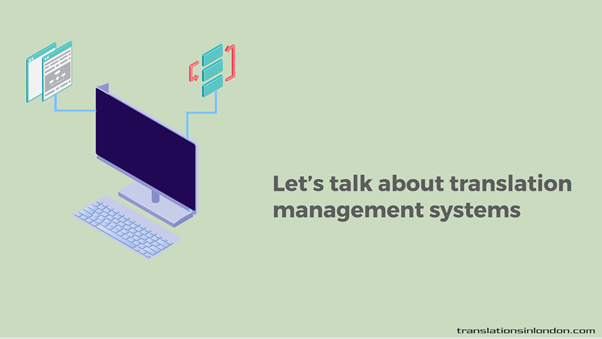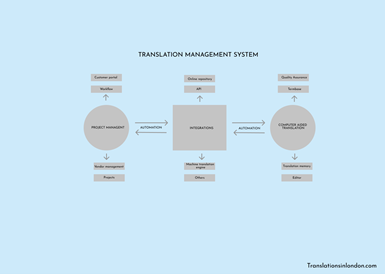
Attaining global commercial success as a brand is not an easy journey.
There are several considerations businesses need to make in order to get to their desired destination. A number of these factors need careful navigation, while others are beyond a brands’ control.
But perhaps the most common denominator within the control of most successful global entities is that they all operate an efficient workflow.
An efficient workflow makes the aforementioned considerations work in unison and effectively. And we daresay that utilizing a translation management system (TMS) brings organizations with global aspirations a step closer to developing an efficient workflow.
Therefore in this post, we would be making a case for translation management systems and why they should be a prime consideration for global brands.
What is a translation management system?
A translation management system (TMS) is as its name suggests. It is a platform that helps companies manage their translation or localization efforts. Every process involved in releasing a global product; the product design, translation, editing, quality assurance, task management, and document exchange are coordinated from one central hub with a TMS. Think of it as a motorway service area where all road users embarking on a trip can stop to access services to make their journey a lot smoother.
A translation management system brings together all sorts of professionals — product designers, copywriters, translators, developers, project managers, etc., under one roof (figurative) to enhance effective collaboration. It also automates most of these stakeholders processes, thereby reducing errors and at the same time improving their workflow efficiency.
What makes up a translation management system?
A translation management system could contain many components. There is no one-size-fits-all description of a TMS’s composition, and its constituents usually depend on the peculiar needs of the organization deploying it.
That is why it is common to find larger enterprises with diverse needs with proprietary translation management systems, while smaller companies or enterprises with more measured needs tend to opt for 3rd party TMS. But going by the previous definition of what a TMS is and what purpose it is meant to serve, we can come up with a simple model of a translation management system that satisfies most of the basic needs of an organization.
A basic TMS could incorporate project management and computer-aided-translation functionalities, while having integrational modules that make it compatible with a wide range of tools for enterprises to use. The simple model illustrated below is by no means the entirety of what a TMS comprises, but just a visual representation of what one might come to expect.

A model TMS
Who needs a translation management system?
Although translation management systems were created to facilitate the operations of language service providers, it has evolved to do much more.
Senior Project Manager at TranslationsinLondon, Valentina Vignolo-Love elaborates on why a TMS is crucial to language service providers.
“A TMS is an essential tool for any LSP that works with many translation vendors. It is not only a quick or more effective tool to assign tasks but also to monitor vendor performances.”
But contrary to popular opinion, TMS’s are no longer meant for LSP’s alone. Any enterprise whether large or small with global ambitions needs to invest to some extent in translation and localization services, and would therefore benefit from utilizing a translation management system.
Even sectors like finance that are usually stringent in adopting 3rd party apps due to security and risk reasons are adopting translation management systems to boost their workflow and hasten product releases.
Liva Paudere, VP of Content Design at DBS, one of the largest banks in Southeast Asia, explains why they opted for a translation management system.
“During development, we constantly had to try to figure out what the correct and final version of the translated copy was. The content was scattered across Word documents, Excel files, emails, Teams messages, etc.”
A TMS provides a centralized platform that addresses these bottlenecks head-on, where these files can be shared and accessed, with translation and other product creation stints occurring in real-time.
What are the benefits of using TMS?
By now, you may already be visualizing the bigger picture regarding why global brands need a translation management system.
It all stems from the desire, or rather, the necessity for enterprises to adopt a framework that makes their entire product creation process proceed smoothly.
On that note, TMS brings the following benefits to organizations;
Improves product quality: The primary objective of most businesses is to make sales, but that can only occur sustainably when value is added to the end consumer.
By utilizing a platform that combines project management and computer-aided-translation functionalities, all stakeholders can work in harmony to create a final product that is free from errors and of the best standard.
Enhances collaboration: Imagine a designer, marketer, and developer working together on the same platform with a project manager to develop a product. That is basically what a TMS facilitates.
A translation management system provides a platform for all relevant stakeholders to interface with one another, exchanging resources, and communicating effectively. Such a platform makes it easier to collaborate towards the collective organizational goal.
Promotes workflow and automation: Anchoring on the previous two points should make it clear to see how a TMS helps boost the workflow and productivity. A TMS could be the difference between operating manually with several processes occurring in batches and running your localization process in a centralized and simultaneously format.
Speaking on how a TMS transforms workflow, Vignolo-Love had this to say.
“To be honest, it revolutionized our workflow. Now all our vendors, projects, invoices, and clients are under one roof, which means we were able to cut down on the barrage of emails. We are also able to monitor a vendor and a project.
Our TMS gives us the ability to work remotely and delegate to other project managers easily and perhaps, most importantly, it sends notifications automatically when deadlines are approaching, keeping everyone on their toes.”
And since most translation management systems are built with automation functions, product development stints can occur faster, which leads to a shorter time to market and also making it easier to scale an enterprise.
Cost savings: Several components of a TMS are geared towards reducing expenditure for enterprises. For starters, translation memory on its own could help with churning out faster translations on the path of LSP’s which is a cost-saving measure, but there are still other ways to look at it.
Adopting a translation management system helps mitigate errors and bottlenecks associated with product development, which otherwise would have financial implications for brands.
Easy access to relevant assets: TMS often comes with document management and the corresponding integrations that make it easy to access assets relevant to product development.
Considerations when choosing a TMS
Choosing a TMS is a crucial and by no means an easy decision that could have dire financial implications for brands if done wrongly. While there are a host of factors to consider when making this choice, decision-makers can always focus on the following key considerations;
Budget: Most translation management systems do not come cheap and just like with any expensive business decision, a lot of thought should be put into it to ensure that the solution being adopted caters to the unique needs of the organization.
It is quite common to find brands going for the extremes (most simple or sophisticated) solution, which could either be too expensive in the case of the latter or too cheap in the former. Instead, decision-makers should go for a product that aligns with the business’s goals and is compatible with the brand’s workforce.
Integration: As long as it is impossible for a TMS to completely integrate every plugin and 3rd-party apps since so many exist performing several functions, enterprises would always have to factor in their integration needs when selecting a TMS.
For instance, if your LSP uses the IBM Watson engine for all their machine translation needs, it is only logical to go for a TMS that integrates that engine in its framework, rather than just going for the most popular product.
Integration is basically the driving force for automation which itself goes a long way to enhancing workflow and productivity.
Ease of use: No matter the functionality of a TMS, either in terms of sophistry or otherwise., it is only as good as its user. That said, Project managers and decision-makers need to factor in the level of sophistry when choosing a translation management system.
An easy to use TMS would take less time for the product team to adopt, thereby making it possible to harness its benefits quicker.
In essence, a TMS should be a tool that is easy enough to facilitate the productivity and efficiency of the product team instead of being a hindrance.
Conclusion
A translation management system is the final piece that completes the jigsaw for organizations that want to scale by going global.
The combination of what a TMS entails from its product management, automation and translation functionalities make collaboration and workflow seem like smooth sailing, but organizations must ensure that due diligence is observed when making the choice of a TMS in order to get the best out of it.
Although deploying a TMS might no longer be an afterthought for companies that want to go global, it needs to be complemented with a language service provider that understands how they work and can merge into your workflow.
Translationsinlondon is a translation and localization service provider that can effectively merge into your routine to ease your global expansion journey.
Give us a call or send a message today to get started.

